Surveying with a GPS
Reviewed 2015-06-07
Learning to edit is one of the key parts of mapping - that is how you add information to the actual map. But the other task is collecting the information itself - that is, going out and surveying an area.
In this chapter we will see what a GPS does and how it works. You will learn how to operate a GPS, and how to use it to create maps.
Here we will explain how to operate the Garmin eTrex Vista HCx, a common GPS used for mapping. There are many other models of GPS which do the same thing, so if you are working with a different one, don’t worry – the principles remain the same.
What is a GPS?
A GPS is like a mobile phone, except that instead of receiving radio signals from telephone companies, it receives signals from satellites that are going around the Earth. By receiving these signals from the satellites, a GPS is able to calculate your exact location on the planet. It records this location in coordinates, which are two long numbers. One number tells you how far East or West you are – this is called longitude. The second number tells you how far North or South you are – this is called latitude. Every place on Earth has unique geographic coordinates.
For example: -8.639298 Latitude, 116.311607 Longitude is a location in Lombok, Indonesia.

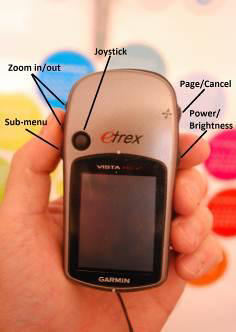
Turn on the GPS
Before you turn on your GPS, go outside where you have a clear view of the sky. Because the GPS determines your location by receiving signals from satellites, it won’t work indoors.
On the right side of your GPS, press and hold the Power button. The GPS will start, and it will show you the Satellites page. You should see something like the image below. Your GPS is looking for satellite signals. When it has connected to three or more satellites, it will have your location.
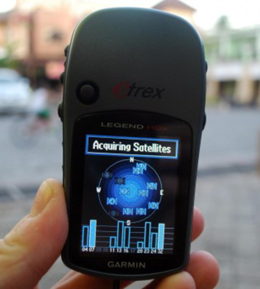
Once your location is determined, the Satellite screen will disappear and you will see the main menu.
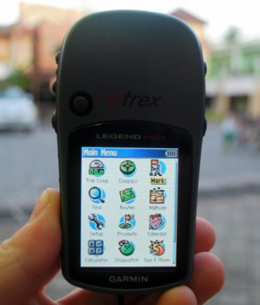
Navigate the GPS
- The GPS has different screens and menus that allow you to do different things. To switch between screens, press the button marked “X”, just above the power button on the right side of the device. This button also serves to go back. If you press something by mistake and would like to cancel or go back, press the “X” button.
- By pressing the X button, you should be able to flip through different screens that will look something like this:

-
If you return to the Satellites page, you can see that you are connected to three or more satellites. In the upper left corner are your coordinates, your latitude and longitude.
-
Flip to the Map page, and you can see a map of where you are. If you have added OSM maps to your GPS, you may see roads and places. Otherwise, the map may look quite blank. Zoom in and out by pressing the up and down arrow buttons on the left side of the GPS.
-
Further information where to obtain OSM maps for Garmin devices and how to install them can be found in the OSM wiki
Tracks and Waypoints
Your GPS records two kinds of information that are useful for creating maps or saving the coordinates of a place. First, it allows you to save your location in the memory of the GPS. When you save a location, the coordinates will be saved with a name. For example, your first saved point will be named 001, the second 002, and so on.
If your GPS does not start at 001 and you would like to clear the previous points, go to the “Find” icon in the main menu. Hit “waypoints” and then the submenu button on the right side to display the Waypoint submenu. Scroll down to “Delete” click “all symbols” and “Yes”.
When you save a point, you can write down the number on a piece of paper, along with a note about what it is, and any attribute or indicators you would like to know. Saved locations on your GPS are called waypoints.
Second, your GPS can save what are called tracks. While a waypoint only saves a single location, a track will save a series of locations wherever you move. For example, the track will record your location every one second, or every one meter, and the result will be a series of dots that show the path of where you have been. Tracks are useful for mapping objects that are represented by lines or shapes, such as the course of a road, or the shape of a field.

Save Your Location
- To save your current location as a waypoint, click the “X” button until your reach the Main Menu. Using the joystick, move it so that “Mark” is highlighted on the screen. Push the joystick button down to open the “Save Waypoint” page. Alternatively, you may press the the joystick button on any page until the “Save Waypoint” page opens.

- You can see on this page some information about the waypoint that you are saving. First is the name. If this is your first waypoint, it probably reads “001”. This is the number you should record on paper along with the information you want to collect with this object. Next you will see the time and date when the point is recorded. Below that are the coordinates, followed by the altitude.
- Use the joystick to move to the “OK” button at the bottom of the screen. Press the joystick button down to save this point. Be sure to write down the number of the point, along with what the place is and any other information you want to record about the place in your notebook.
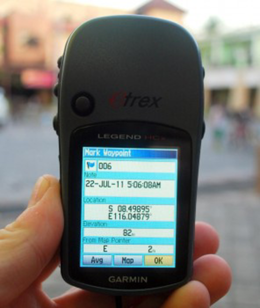
- Press the “X” button to go to the map page. You should now see your point on the map.
Turn on the Track Log
- Now that we have learned how to save points, let’s learn how to turn the track log on and off. When the track log is turned on, it will automatically record your path. It’s good practice to turn on the log when you begin mapping, and turn it off when you are finished. You will then be able to look at the track on a computer and see the path that you mapped. If you would like to map the course of a road, it is a good idea to save a waypoint at the beginning and end of the road, writing in your notebook the name and type of the road, and any other important information about the road.
- To turn on the track log, click the “X” button until your reach the page that says Track Log.
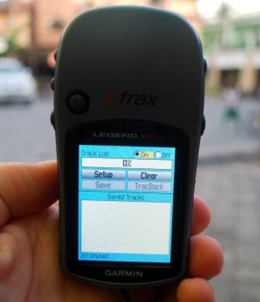
- If you would like to empty the track log to delete earlier recordings, use the joystick to select “Clear”, and press the joystick down. The bar at the top should read “0%”.
- To turn on the log, move the joystick to highlight “On”, and press the joystick down. The track log is now recording your path.
- Under the “Set up” option, you also can set time or distance intervals to track. Time intervals instruct your GPS to record your location at given intervals. If you have a memory card in your GPS, it is good practice to set this to 1 second, meaning that every second your location will be added to the track log. This may be useful when detailed surveys are needed.
- Press the “X” button to go to the map page. As you move you will see your track shown as a series of dots.
Copy Waypoints and Tracks to the Computer
When you are finished mapping with the GPS you will want to copy the points and tracks to your computer so that you can open them in JOSM.
One way to copy the waypoints and tracks is to you use the free software that Garmin provides, called BaseCamp. It can be downloaded here. However, in this section we will use a program called GPSBabel, which offers a few additional features.
Attach GPS to the Computer
- First, turn off the track log on your GPS, by going to the track page and selecting “Off”.
- Attach the GPS to your computer with the cable. One end should plug into your computer’s USB port, and the other goes into the back of the GPS, beneath the rubber flap at the top. The GPS should be turned on to copy the points and tracks.
Install GPS Drivers
- You may need to install GPS drivers on your computer. You can download the drivers at the Garmin Website.
- Click “Download” to get the installation file. Locate it on your computer, and double-click to install.
Linux systems (at least Fedora) do not need special drivers to communicate with a Garmin device (at least the eTrex Vista HCx). Just make sure that your Garmin is powered and plug it into your compure with a USB cable. You can use GPSBabel (as instructed below) or GpsPrune to grab the saved data from your device.
Get the GPSBabel Setup Program
- GPSBabel is a program that allows us to copy data from the GPS. If you have a copy of GPSBabel on a CD or usb flash drive, you can skip to the next section.
- If you don’t have GPSbabel already, open your web browser and go to www.gpsbabel.org
- Click “Downloads” at the top of the page.
- Scroll down the page. If your computer uses Windows, you want to download the installation file for Windows. Click “GPSBabel-1.5.2-Setup.exe”. The file will be downloaded to your computer.
Install GPSBabel
- Locate the GPSBabel setup file on your computer. Double-click it to install.
- Click “Next”.
- Click “I accept” and “Next”.
- Continue clicking “Next” until the program installs.
- When the program has finished installing, click “Finish” to start GPSBabel.
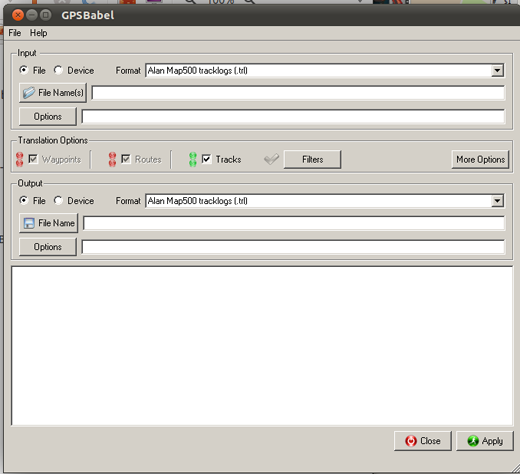
Copy Tracks and Waypoints
- Click in the circle next to the word “Device” at the top of the window.
- In the dropdown menu labelled “Format”, select “Garmin serial/USB protocol”
- Go down to the middle of the window, under Output. In the dropdown menu labelled “Format”, select “GPX XML”:

- Click “File Name” and type a name for your saved file. It should be something that describes the data, such as the date and the location. For example, jakarta-07-07-2011
- Make sure your GPS is connected to the computer and turned on.
- Click “Apply” in the bottom right corner of the window.
- If all goes well you should see a bar move across the screen, indicating that the data is being retrieved from the GPS. When it is finished, your points and track will be saved in the file that you selected.
Open in JOSM
- Now open JOSM. On the top menu, click “File” and then click “Open…”
- Find and select the file that you created with GPSBabel. Click “Open”.
- You should now see your points and tracks loaded into JOSM.
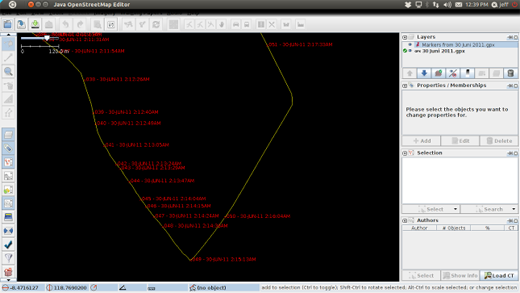
Summary
Congratulations! You should now have an understanding of how to use the GPS. If you haven’t already, practice saving points of some important locations.
In this section we learned how to collect points and tracks and open them in JOSM. Later, we will use this information to add new places to OpenStreetMap.













 Return to top of page
Return to top of page